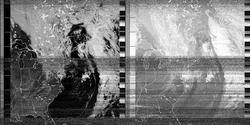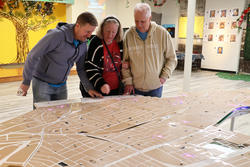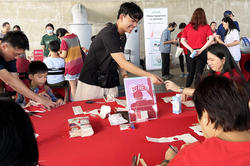Students in a spring studio called Clay Matters conduct material investigations in support of their evolving thesis projects.
Somerson Sustainability Innovation Fund Supports Social Justice and Planetary Health

RISD’s commitment to advancing sustainable design and climate justice can be seen in studios across campus, collaborations with external partners and funding available through Research & Strategic Partnerships, including the Somerson Sustainability Innovation Fund (SSIF). Endowed by alum Sarah Sharpe 94 GD and named after President Emerita Rosanne Somerson 76 ID, the SSIF offers RISD faculty and students substantial support ($10k–25k) for transdisciplinary research and creative practices that address sustainability issues.
The second round of SSIF-funded projects are well underway and include work by longtime Architecture faculty member Laura Briggs BArch 82, Associate Professor of Graphic Design Anastasiia Raina and recent grad Yizhou “Viola” Tan BArch 24 as well as a collaborative endeavor by alums Maxwell Fertik MID 23 and Erika Kane MDes 22. “What the projects have in common,” says Director of Research Soul Brown, “is bold, imaginative and interdisciplinary research concepts aiming to restore the health of our planet and communities.”
Briggs is focusing her efforts locally, partnering with Harvest Cycle-Groundwork RI on a neighborhood composting facility—the West End Compost Hub (WECH)—on Providence’s West Side that will also serve as a space for material experimentation and on-site testing of plastic alternatives. The facility, which is not yet constructed, will create high-quality compost that can be used to grow food and rejuvenate urban soils degraded by fertilizers and extractive farming.
“What the projects have in common is bold, imaginative and interdisciplinary research concepts aiming to restore the health of our planet and communities.”

WECH will also serve as a model for a larger composting network within the surrounding communities. Each of these hubs will be places for researching alternative building materials to replace traditional petroleum-based plastics and toxic sealants, providing educational opportunities for conservationists of all ages. The findings will be presented through public exhibitions, presentations and symposiums, as well as online platforms.
Also working with partners in New England, including the Community Action Agency of Somerville (CAAS), Tan used her funding to develop a project called Tenant Power that aids Massachusetts-based renters in advocating for improved living conditions and affordable housing. With guidance from Eric Huntley, a faculty member at MIT, she conducted data analysis uncovering a network of corporate landlords in Massachusetts—known for evicting tenants more frequently than noncorporate landlords—and then created a visual representation of that data in the form of an installation, which she shared at Connexion United Methodist Church in May.
“The specific design for the installation evolved a lot, from individual LEDs to printed circuit boards,” Tan says, “thanks to my advisor, Gavin Robb, who continued to push me and brainstorm with me. Overall, the project seeks to create a future where communities are empowered, housing is accessible and affordable, and sustainable housing practices are prioritized.”

Fertik and Kane are also thinking locally, envisioning uses for the non-native but locally sourced perennial Japanese knotweed, which is considered to be an invasive species. “The project promotes sustainability by using what is already abundant and considers the radical reuse of invasive species waste,” the designers explain.
Since January, they have produced a series of objects from the knotweed and another post-industrial material: scrap aluminum. First, they created smokeless incense from knotweed biochar (a carbon-rich charcoal made from organic biomass, created using pyrolysis). They then melted down scrap aluminum from an East Providence machine shop and cast one-off holders for the incense. They also ground the dried knotweed down to a pulp to create a prototype for a cheap alternative to sheet stocks like OSB and particle board. “SSIF has provided us with the immense opportunity to travel for our research, purchase equipment and have the time needed to experiment with casting, pulping and creating biochar,” Fertik adds.

Finally, Raina’s project, Data Imaginaries Lab, focuses on creating a space for exploration and artistic experimentation with ecological data-driven art and design objects, publications and immersive experiences. Offering workshops and talks, the lab provides a collaborative platform for RISD students to engage with science researchers and serves as a testing ground for novel ways of visualizing ecological, Rhode Island-based data. In one workshop, students used affordable amateur radio technologies and open-source software to capture weather satellite transmissions from three orbiting National Oceanic and Atmospheric Administration (NOAA) satellites (see top image).
“Climate change and the rise of big data and artificial intelligence are the main factors shaping our near future,” Raina says. “We need to move beyond human-centric datasets and develop new visual methods to recontextualize and reimagine whole natural systems that make life on Earth possible.”
Simone Solondz / top image: NOAA-19 satellite pass, April 28, 2024, captured by Anastasiia Raina
August 12, 2024


